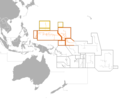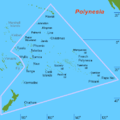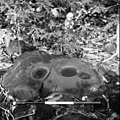An orthographic projection of Oceania
Oceania OH -s(h)ee-AH -nee-ə, -AY -OH -shee-A(H)N -ee-əgeographical region including Australasia , Melanesia , Micronesia , and Polynesia . Spanning the Eastern and Western Hemispheres , at the centre of the water hemisphere , Oceania is estimated to have a land area of about 9,000,000 square kilometres (3,500,000 sq mi) and a population of around 44.4 million as of 2022. When compared to the continents (which it is often compared to, not including Australia), Oceania is the smallest in land area and the second-least populated after Antarctica .
Oceania has a diverse mix of economies from the highly developed and globally competitive financial markets of Australia , French Polynesia , Hawaii , New Caledonia , and New Zealand , which rank high in quality of life and Human Development Index , to the much less developed economies of Kiribati , Papua New Guinea , Tuvalu , Vanuatu , and Western New Guinea , while also including medium-sized economies of Pacific islands such as Fiji , Palau , and Tonga . The largest and most populous country in Oceania is Australia, and the largest city is Sydney. Puncak Jaya in Highland Papua , Indonesia , is the highest peak in Oceania at 4,884 m (16,024 ft).
The arrival of European settlers in subsequent centuries resulted in a significant alteration in the social and political landscape of Oceania. The Pacific theatre saw major action during the First World War with the Japanese occupying many German territories. During the Second World War , Allied powers the United States , Philippines (a U.S. Commonwealth at the time) and Australia fought against Axis power Japan across various locations in Oceania. (Full article...
Polynesia is one of three major cultural areas of the Pacific Ocean islands , along with Melanesia and Micronesia . Polynesia POL -in-EE -zee-ə-EE -zhə subregion of Oceania , made up of more than 1,000 islands scattered over the central and southern Pacific Ocean . The indigenous people who inhabit the islands of Polynesia are called Polynesians . They have many things in common, including language relatedness , cultural practices , and traditional beliefs . In centuries past, they had a strong shared tradition of sailing and using stars to navigate at night.
The term
Polynésie was first used in 1756 by the French writer
Charles de Brosses , who originally applied it to all the
islands of the Pacific . In 1831,
Jules Dumont d'Urville proposed a narrower definition during a lecture at the
Société de Géographie of Paris. By tradition, the islands located in the
southern Pacific have also often been called the
South Sea Islands , and their inhabitants have been called
South Sea Islanders . The
Hawaiian Islands have often been considered to be part of the South Sea Islands because of their relative proximity to the southern Pacific islands, even though they are in fact located in the
North Pacific . Another term in use, which avoids this inconsistency, is "the
Polynesian Triangle " (from the shape created by the layout of the islands in the Pacific Ocean). This term makes clear that the grouping includes the Hawaiian Islands, which are located at the northern
vertex of the referenced "triangle". (
Full article... )
List of geographic articles
August 2016 boundary and location
The Papahānaumokuākea Marine National Monument World Heritage listed U.S. National Monument encompassing 583,000 square miles (1,510,000 km2 ) of ocean waters, including ten islands and atolls of the Northwestern Hawaiian Islands . It was created in June 2006 with 140,000 square miles (360,000 km2 ) and expanded in August 2016 by moving its border to the limit of the exclusive economic zone , making it one of the world's largest protected areas . It is internationally known for its cultural and natural values as follows:
The area has deep cosmological and traditional significance for living Native Hawaiian culture, as an ancestral environment, as an embodiment of the Hawaiian concept of kinship between people and the natural world, and as the place where it is believed that life originates and to where the spirits return after death. On two of the islands, Nihoa and Mokumanamana , there are archaeological remains relating to pre-European settlement and use. Much of the monument is made up of pelagic and deepwater habitats, with notable features such as seamounts and submerged banks, extensive coral reefs and lagoons.
(
Full article... )
List of selected articles
The following are images from various Oceania-related articles on Wikipedia.
Image 2 Polynesians with
outrigger canoes at
Waikiki Beach ,
Oahu Island , early 20th century (from
Polynesia )
Image 4 Chronological dispersal of
Austronesian peoples across the
Indo-Pacific (from
Micronesia )
Image 5 Mokoliʻi Isle near
Oahu ,
Hawaii (from
Polynesia )
Image 6 Outline of sovereign (dark orange) and dependent islands (bright orange) (from
Micronesia )
Image 7 Moai at Ahu Tongariki on
Rapa Nui (from
Polynesia )
Image 8 Cinder plain of
Mount Yasur in
Vanuatu (from
Melanesia )
Image 9 A common fishing canoe
va'a with outrigger in
Savaiʻi island,
Samoa , 2009 (from
Polynesia )
Image 10 Outline of sovereign (dark orange) and dependent islands (bright orange) (from
Polynesia )
Image 11 Canoe carving on
Nanumea atoll, Tuvalu (from
Polynesia )
Image 14 Kili Island is one of the smallest islands in the
Marshall Islands . (from
Micronesia )
Image 16 A depiction of a royal
heiau (Hawaiian temple) at
Kealakekua Bay , c. 1816 (from
Polynesia )
Image 17 Polynesia is generally defined as the islands within the
Polynesian Triangle . (from
Polynesia )
Image 18 Melanesia is one of three major cultural areas of the
Pacific Ocean islands , along with
Micronesia and
Polynesia . (from
Melanesia )
Image 19 Map of Melanesia, showing its location within Oceania (from
Melanesia )
Image 20 The arrival of
Abel Tasman in
Tongatapu , 1643; drawing by
Isaack Gilsemans (from
Polynesia )
Image 21 German trading station at
Jaluit Atoll with a Marshallese
korkor outrigger canoe in the foreground (from
Micronesia )
Image 22 Australia's concept of Australasia, which includes Australia, New Zealand and, in this case,
Melanesia (from
Australasia )
Image 23 Aerial view of
Solomon Islands (from
Melanesia )
Image 24 Chamorro people in 1915 (from
Micronesia )
Image 25 Grinding stones discovered from
archaeology in Samoa (from
Polynesia )
Image 26 Outline of sovereign (dark orange) and dependent islands (bright orange) (from
Melanesia )
Image 27 Languages of Micronesia. (from
Micronesia )
Image 28 Micronesia is one of three major cultural areas of the
Pacific Ocean islands , along with
Melanesia and
Polynesia . (from
Micronesia )
Image 29 Mount Marpi in
Saipan . (from
Micronesia )
Image 31 Painting of
Tahitian Women on the Beach by
Paul Gauguin —
Musée d'Orsay (from
Polynesia )
Image 32 The Polynesian spread of colonization in the Pacific (from
Polynesia )
Image 33 Sailors of Melanesia in the
Pacific Ocean , 1846 (from
Melanesia )
Image 34 Subregions (
Melanesia ,
Micronesia ,
Polynesia and
Australasia ), as well as sovereign and dependent islands of
Oceania (from
Micronesia )
Image 35 On February 14, 1779, Capt.
James Cook was killed on the island of Hawaii (from
Polynesia )
Image 36 German New Guinea before and after the German-Spanish treaty of 1899 (from
Micronesia )
Image 37 A
Melanesian child from
Vanuatu (from
Melanesia )
Image 38 Carving from the ridgepole of a
Māori house, ca 1840 (from
Polynesia )
Image 39 Beach scenery at
Laura ,
Majuro , Marshall Islands (from
Micronesia )
Image 40 Subregions (
Melanesia ,
Micronesia , Polynesia, and
Australasia ), as well as sovereign and dependent islands of
Oceania (from
Polynesia )
Image 41 Polynesian (Hawaiian) navigators sailing multi-hulled
canoe , c. 1781 (from
Polynesia )
Image 42 Polynesia is one of three major cultural areas of the
Pacific Ocean islands , along with
Melanesia and
Micronesia . (from
Polynesia )
Image 43 Chronological dispersal of
Austronesian peoples across the
Indo-Pacific (from
Melanesia )
Image 44 Māori
war canoe drawn after
James Cook 's voyage to New Zealand. (from
Polynesia )
Image 45 Cook's Bay on
Moorea ,
French Polynesia (from
Polynesia )
Image 46 Map showing the migration and expansion of the
Austronesians which began at about 3000 BC from
Taiwan . The Polynesian branch is shown in green. (from
Polynesia )
Image 48 A pan flute from
Solomon Islands , 19th century (from
Melanesia )
Image 50 King
Kamehameha I receiving the Russian naval expedition of
Otto von Kotzebue . Drawing by
Louis Choris in 1816. (from
Polynesia )
Image 51 An illustration of the Cross Spikes Club of the US Navy on
Bikini Atoll , one of several Marshall Islands used for
atomic bomb tests . (from
Micronesia )
Image 52 Image of the
Castle Bravo nuclear test, detonated on 1 March 1954, at
Bikini Atoll (from
Micronesia )
Australasia Melanesia Micronesia Polynesia
Adamstown Pitcairn Islands 6 Alofi Niue 7 Apia Samoa Avarua Cook Islands 7 Fakaofo Tokelau 8 Funafuti Tuvalu Mata Utu Wallis and Futuna 2 Nukuʻalofa Tonga Pago Pago American Samoa 4 Papeete French Polynesia 2
Category puzzle Select [►] to view subcategories
Here are some tasks awaiting attention:
Wikipedia in other languages used in Oceania:
Purge server cache







































































